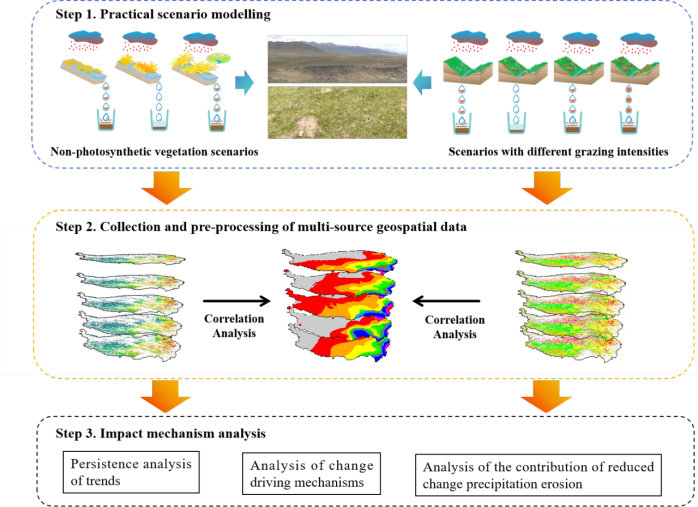
Rainfall erosion is a complex environmental problem involving multiple influences, both natural and human. To explore effective strategies to suppress the erosive power of rainfall on the Qinghai-Tibet Plateau, researchers considered the complexity of regional geographic features. This paper also accounted for the variability of livestock carrying capacity across different grasslands. Based on the raster data of changes in non-photosynthetic vegetation cover and livestock carrying capacity on the Qinghai-Tibet Plateau from 2000 to 2019, this study employs partial correlation analysis and multiple residual regression. These methods are used to verify the correlation between precipitation erosive power and changes in non-photosynthetic vegetation cover. Additionally, the study assesses the contribution of these changes from the image metric perspective. The results showed that: (1) the erosive power of rainfall on the Qinghai-Tibet Plateau has experienced ‘N’-shaped fluctuations, and its spatial distribution shows an increasing trend from northwest to southeast. (2) Non-photosynthetic vegetation cover was positively correlated with rainfall erosivity in the central part of the Plateau. However, it was negatively correlated in the southern and northeastern parts. The positive and negative correlation zones of grassland carrying capacity were staggered. (3) Non-photosynthetic vegetation cover and grassland livestock carrying capacity together affected 17.66% of the image area with increased rainfall erosivity. In contrast, only 3.07% of the image area experienced reduced rainfall erosivity. This imbalance raises the risk of overall rainfall erosivity. (4) The contribution of livestock carrying capacity to the increase of rainfall erosivity was 26.99%, which is higher than the 17.38% contribution of non-photosynthetic vegetation cover. Non-photosynthetic vegetation cover, however, played a more significant role in reducing rainfall erosivity. In order to provide a scientific basis for the land conservation and sustainable development of the Qinghai-Tibet Plateau, this study aims to offer valuable insights and recommendations.
Total file downloads: 19